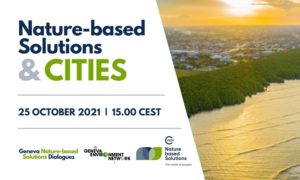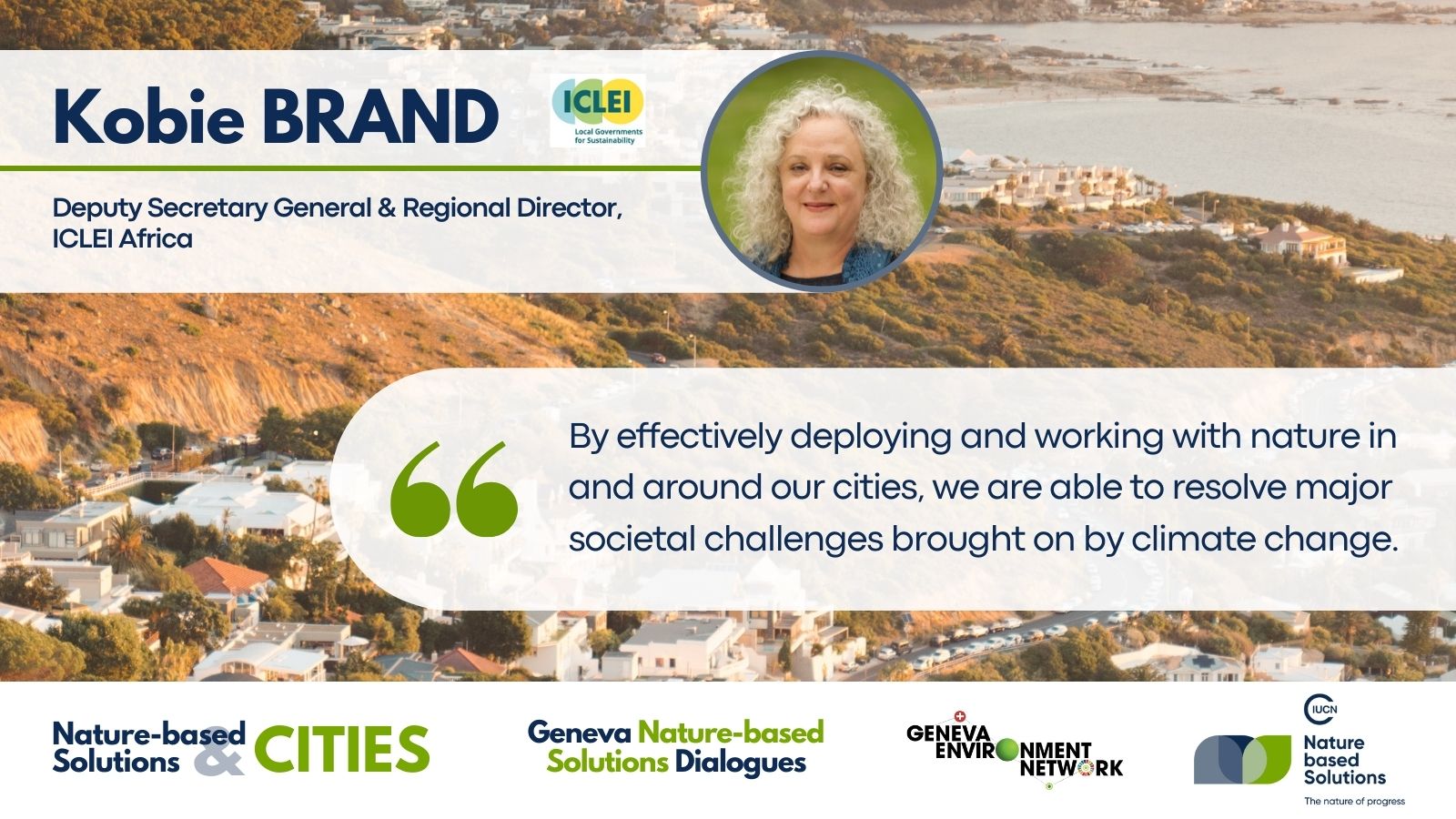Événement Virtuel
Nature-based Solutions and Cities | Geneva Nature-based Solutions Dialogues
The Geneva Nature-based Solutions dialogues aim to facilitate further engagement and discussion among the stakeholders in International Geneva and beyond, in the lead-up to a critical year for nature and society. The dialogues are convened by the Geneva Environment Network and the International Union for Conservation of Nature (IUCN).
About the Dialogues
We are facing a triple planetary crisis – climate change, nature loss and pollution. In this context, Nature-based Solutions (NbS) are a powerful ally to address a societal and environmental challenges. As per IUCN definition, NbS are actions to protect, sustainably manage and restore natural or modified ecosystems that address societal challenges effectively and adaptively, simultaneously providing human well-being and biodiversity benefits.
NbS are a powerful tool to facilitate and catalyse the engagement of cross-sectoral stakeholders to join forces towards the implementation of an ambitious Post-2020 Global Biodiversity Framework (GBF) and move towards achieving the CBD 2050 Vision of ‘Living in harmony with nature’. NbS also offer a pathway for synergies among several multilateral environmental agreements, including for biological diversity (CBD), climate change (UNFCCC), disaster risk reduction (Sendai Framework), desertification (UNCCD) and the wider Sustainable Development Goals (SDGs) – and for mainstreaming nature conservation into sectoral decision-making processes.
In the lead-up to a critical year for nature and society, NbS offer an opportunity to address a wide range of urgent societal challenges. The year 2021 and the major upcoming negotiations should indeed mark a turning point towards a resilient world for future generations.
Join the Geneva Environment Network and the International Union for Conservation of Nature in a one-year journey, where experts from all over the world and different sectors will discuss throughout the year how NbS are relevant to various debates ongoing in Geneva.
Sessions
- Nature-based Solutions and Health | 26 April
- Nature-based Solutions and Ecosystems Restoration | 7 June
- Nature-based Solutions and the Post-2020 Biodiversity Framework | 28 June
- Decent Work Through Nature-based Solution for an Inclusive Socio-Economic Recovery | 30 August
- Nature-based Solutions and Food | 13 September
- Nature-based Solutions and the Ocean | 27 September
- Nature-based Solutions for Building Resilience | 11 October
- Nature-based Solutions and Peacebuilding | 1 November
- Nature-based Solutions and Water | 22 November
- Nature-based Solutions and People | 6 December
About this Session
Cities worldwide are increasingly suffering from the effects of climate-related disasters, such as floods, droughts, sea-level rise, heatwaves, landslides, and storms. Meanwhile, cities face important societal challenges, including poverty reduction and the provision of basic services, livelihoods, and accessible, affordable, and adequate housing. With more than half of the world’s population living in urban areas – a ratio projected to increase to 68% by 2050 -, developing comprehensive solutions to jointly address environmental, societal and economic challenges in cities is essential.
In this context, Nature-based Solutions (NbS) provide a framework to address these multifaceted challenges. Within cities, NbS such as tree-covered areas along streets or parks and wetlands, can reduce the urban heat island effect and cooling needs through natural shading, manage run-off water with fewer flooding events, and improve health and well-being, both directly and through recreational opportunities. Around cities, NbS interventions can help with watershed management, recreational space, managing wildfires, improving drinking water quality, reducing, and capturing CO2 emissions, and reducing the impact of sand and dust storms.
NbS are a powerful tool to enhance resilience, support sustainable development, improve the quality of life of urban citizens and safeguard biodiversity. They also provide cost-effective approaches to urban sustainability challenges. Indeed, the co-benefits they provide in terms of public health, social cohesion, or climate change mitigation, are likely to exceed the cost of implementation and maintenance. Thus, NbS can create win-win solutions for society, the environment and the economy.
As the global community celebrates World Cities Day on 31 October, this year’s theme – “Adapting Cities for Climate Resilience” – invites us to rethink how we can reduce climate-related risks for urban populations, including through the use of NbS. Leading experts at this session discussed the potential of NbS for sustainable urban development and resilience, and the needed future action to mainstream NbS in urban planning and policies at the city level.
Speakers
By order of intervention.

Chantal van HAM
Acting Director, European Regional Office, IUCN

Kobie BRAND
Deputy Secretary General & Regional Director Africa Secretariat, ICLEI

Paola DEDA
Director, Forests, Land and Housing Division, UNECE

Renata POLLINI
Sustainable Development, Head of Nature, HOLCIM
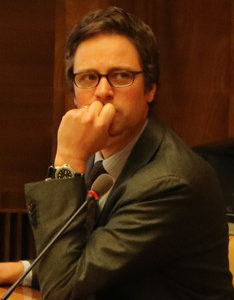
Rowan PALMER
Programme Management Officer, Resources and Markets Branch, UNEP | Lead of the Sustainable Infrastructure Partnership

Helen DING
Senior Environmental Economist, WRI Center of Excellence in Economics | Head, WRI Circular Economy Knowledge Hub

Rodrigo RAVENA
Chief of Staff, Municipal Secretariat of Green and Environment, São Paulo City

Bongani MNISI
Manager, Environmental Planning & Sustainability, City of Cape Town

Mariana VIDAL MERINO
Senior research analyst, PlanAdapt

David MADDOX
Executive Director, The Nature of Cities, ecologist & theatre artist
Summary
Welcome and Introduction
Setting the Scene | Chantal Van Ham, IUCN
- There are 10,000 cities on Earth and half of them didn’t exist 40 years ago.
- Human activity has, unfortunately, impacted nature in practically every part of the world with wild plants and animals at risk of extinction, deforestation, and land degradation causing water scarcity and erosion. Climate change is also leading to many effects such as acidification of oceans, scarcity of water and unbearable temperature increase.
- Urban ecosystems are extremely degraded. Poor planning has resulted in sealing soils and leaving little spaces for vegetation. Urban planning would benefit tremendously if we recognize the connection between cities and their surrounding ecosystems. There is so much we can learn from the extraordinary wisdom that nature has in today’s highly urbanized world.
- We often forget the voice that nature is. We don’t hear it. We don’t listen to it.
- Cities also they harbor a significant fraction of the world’s biodiversity so they can be made more livable and more nature friendly if we learn from nature; knowing that if we lose them, we may also lose perhaps the foundation of life on this planet. For example, bats play an important role in combating corn crop pests that can save millions of euros and dollars in reducing damage to crops.
- For IUCN, the cooperation with cities is a growing priority. IUCN considers cities and sub-national governments as key partners in achieving international biodiversity and climate objectives as well as the SDGs. Cities with Nature is an important platform to give cities access to knowledge on nature and best practices. We have also seen a growing interest for cities in IUCN culminating in a new membership category at the IUCN World Congress that took place last month in Marseille; sub-national governments can now become part of the global union of members and we hope that that will bring also new opportunities to connect IUCN’s global expertise about nature and biodiversity to cities and help them integrate the value of nature better in their plans.
- For IUCN’s Global Program for 2030, we have established three years ago the IUCN Urban Alliance to develop a tool – Urban Nature Index – for cities to assess the value of their natural assets and explore how they can help to integrate nature better in all decision-making processes at the urban level.
- In addition, Panorama Solutions is an initiative that IUCN launched some years ago with a number of partners that has now become an automatic community on sustainable urban development and resilience, comprising hundreds of inspiring and impactful scalable solutions for nature and conservation in cities. The Nature for All initiative that was launched by the IUCN commission on education and communication and the IUCN world protected areas community to inspire a movement for the love of nature, connecting people with nature, and advance our thinking and problem-solving skills related to the many challenges that we face.
- IUCN would like to build new partnerships for action to share our knowledge and expertise and to ensure that nature conservation becomes part of actions at the urban level. Investing in nature-based solutions, trees, rivers, parks, wetlands and urban forests can help cities to provide services and benefits that we need to address climate change and challenges such as health. We can also save a lot of money, for example, in preventing flooding and other climate- related disasters, in reducing air pollution and urban heat, and in building the resilience of cities.
- We share the mission of this century to restore our natural areas, disconnect economic development from environmental degradation, and create a balance between nature and the living environment while at the same time enabling business opportunities that are regenerative and not harmful to our planet. We believe that cities are excellent places to create that change.
First Panel – Multi-disciplinary and multi-scale partnerships in cities
Working with Cities to Implement NbS Towards a Cohesive Urban Society | Kobie Brand, ICLEI
- High levels of biodiversity and nature in cities lead to better resilience. Healthy ecosystems act as buffers against hazards and the impacts of climate change while building resilience, sustaining livelihoods, creating jobs, and supporting recovery actions from disasters.
- In Italy, we are working with cities and local governments to implement nature-based solutions towards the cohesive urban society, enabling governments at all levels – from local to national – to integrate their efforts for mainstreaming biodiversity and ecosystem services into core sub-national government functions: special planning, land use management, local economic development and infrastructure design.
- Cities with Nature is one of our flagship global initiatives to enhance the value of nature in and around our cities and regions across the world and to provide shared platforms for cities, regions and their partners to engage, learn, and connect with each other towards a more sustainable future. By bringing cities and regions together with nature, we aim to mitigate local threats to biodiversity. At the global level, through international collaboration and providing space for cities and regions to learn, share and showcase their actions and commitments, the program provides benefits, tools, resources and technical services not only to city and regional administrators but also to all stakeholders, including urban communities and scientists.
- The initiatives are successful because of the involvement of major partners such as IUCN, UNEP, WWF and many others. It is only through collaborative exchanges that important commitment can be achieved at the scale we need.
- There is an overwhelming scientific consensus and evidence indicating that nature is essential to human existence, that nature plays a critical role in meeting our societal needs. The sustainable development of natural resources, therefore, has an important role in achieving the SDGs. By effectively deploying and working with nature, we are able to resolve major societal challenges brought on by climate change. Nature works tirelessly on our behalf, providing us with our essential needs in order to tackle the climate crisis.
- Cities around the world have to rethink and redesign how they treat and incorporate their natural infrastructure. Natural resources management needs to be strengthened through improved policy, governance, and collective action. Nature-based development is one of our equally five key pathways where we commit to protecting and enhancing biodiversity and ecosystems in and around cities.
- We engage cities through advocacy, leadership development, peer-to-peer learning, local implementation projects and physical and virtual engagements. We support local leaders to apply sustainable governance practices and advocate for multi-level governance in the negotiation and implementation of the UN conventions.
- Nature-based solutions are cost-effective and sustainable in reducing disaster management and risks. They are also essential in growing urban communities and economies and in adapting to climate change.
Sustainable Urban Forestry and the Potential of Trees as NbS in Cities | Paola Deda, UNECE
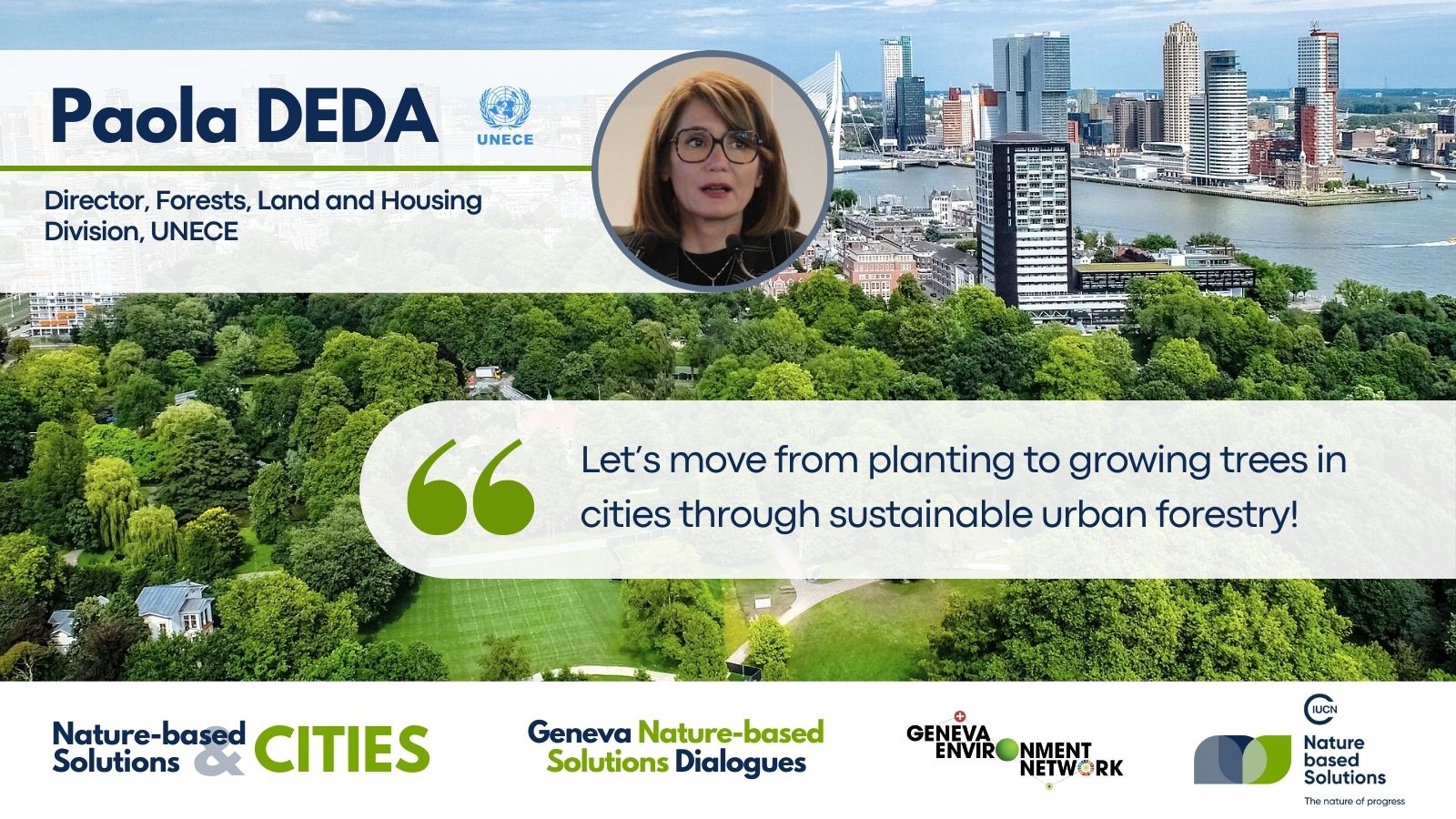
- We are dealing with both forests and urban development and indeed, nature-based solutions are a priority. Cities will host two-thirds of humanity by 2050. We will be in an urbanized world and achieving local objectives and national agendas for sustainable development depends on having vibrant and resilient cities. We cannot do it without the support and engagement of cities.
- Cities are responsible for about 75% of global CO2 emissions and they are on the forefront on the fight against climate change. We need to work with cities and to change cities if we want to tackle the issue of climate change.
- For example, trees benefit cities, not only because of their CO2 absorption power but also because of their cooling ability. In addition, a well-connected network of trees in our own cities restores biodiversity. There is also an enormous positive impact on public health as trees purify the air. However, accessing their benefits requires more than simply planting trees. We have to move from planting to growing trees in cities, in creating ecosystems – ensuring we select the correct species and building the correct ecosystems for the particular city. Trees in cities also increase the value of real estate.
- When we look at the challenges of growing trees in cities, the first is actually a policy challenge. There is lack of strong laws to conserve trees in cities, a missing engagement from various city stakeholders and communities, and unfavorable conditions to access adequate financing. There is also competition for limited space and urban land is expensive. In addition, there is a lack of cross-sectoral cooperation between different sections in the municipality and a missing long-term perspective. Trees don’t grow on a in a day and we need to look out for the next generation. Furthermore, there is the challenge in managing the ever-changing conditions caused by global warming. We notice that many seeds are losing to certain species and there is insufficient management, concepts, knowledge, and monitoring to improve performance. It is not easy to monitor urban forests but cities need to overcome these challenges and need specific long-term sustainable urban forestry strategies.
- UNECE is looking at policies and focusing on actions. It’s important to note that each city is unique peculiar and requires specific solutions. We recently established an informal network of experts on sustainable urban forestry, which includes city representatives and experts who are invited to participate in a knowledge exchange to learn from peers. Solutions that apply in a certain city cannot necessarily be replicable in another. To stimulate action and support advocacy in this area, we have implemented the Trees and Cities Challenge since 2019. It’s a global campaign inviting mayors from all over the world to commit to restore, protect and sustainably manage urban trees and forests. We are working together with IUCN and, so far, cities from 16 countries have joined the challenge. They have pledged over 11 million trees and have actually planted over 8 million already.
- We want to stress the important message that we are not only looking at trees or urban forestry but really establishing complete ecosystems in cities. We believe that will be the solution to make cities much more viable and sustainable.
Challenges and Opportunities of NbS in Cities from a Business Perspective | Renata Pollini, Holcim
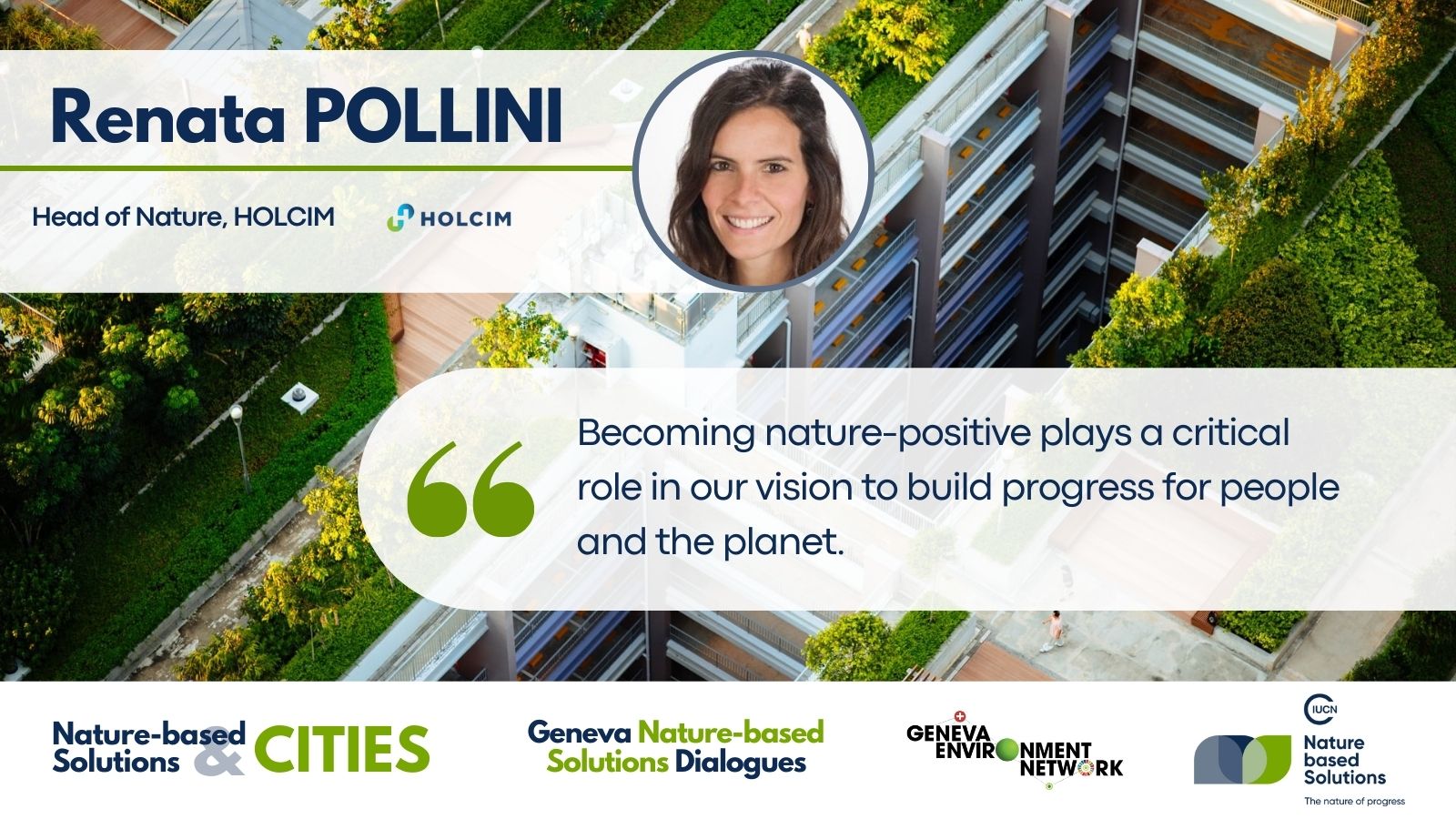
- At the IUCN World Congress in September this year, we launched our new nature strategy where we are committing to deliver a measurable and positive impact on biodiversity backed by scientific standards – to reconcile nature with cities by deploying nature-based solutions.
- We see many opportunities in nature-based solutions but there are also implementation challenges.
- Climate change and biodiversity loss are intrinsically linked. Both are critical societal challenges and nature-based solutions could address one-third of the reduction needed to limit the temperature rise to 1.5C. In nature we find the most effective ways of combating climate change. By implementing nature-based solutions in cities, we can minimize heat-island effects, enhance biodiversity, restore the natural water cycle and even improve air quality. Nature-based solutions not only reduce the impacts of climate change but also increase resilience against those impacts. For example, our Hydromedia product is a permeable concrete enabling rapid evacuation of water directly into the soil, producing a natural aquifer recharge, allowing urban forests to grow. We also have green roofs, a roofing system covered with a layer of living plants over a waterproof membrane. This improves air quality and rainwater management and enhances biodiversity in urban centers.
- However, we face challenges when implementing nature-based solutions. There is a technical need for agreement on nature-based solutions definitions, their standards and measurable indicators, which need to be complemented with knowledge of impacts, potential trade-offs, and incentives for business to accelerate implementation. While Holcim is a large company, our impact in the world is limited so in order to scale and accelerate the uptake of acceptance of nature-based solutions, we would need actions at the governmental level to be taken to mainstream nature-based solutions in urban planning and policies at city level. Only when we reach this stage of attention will we be able to amplify our positive impact on nature.
Meeting the SDGs and Climate Goals through Sustainable and Resilient Infrastructure | Rowan Palmer, UNEP
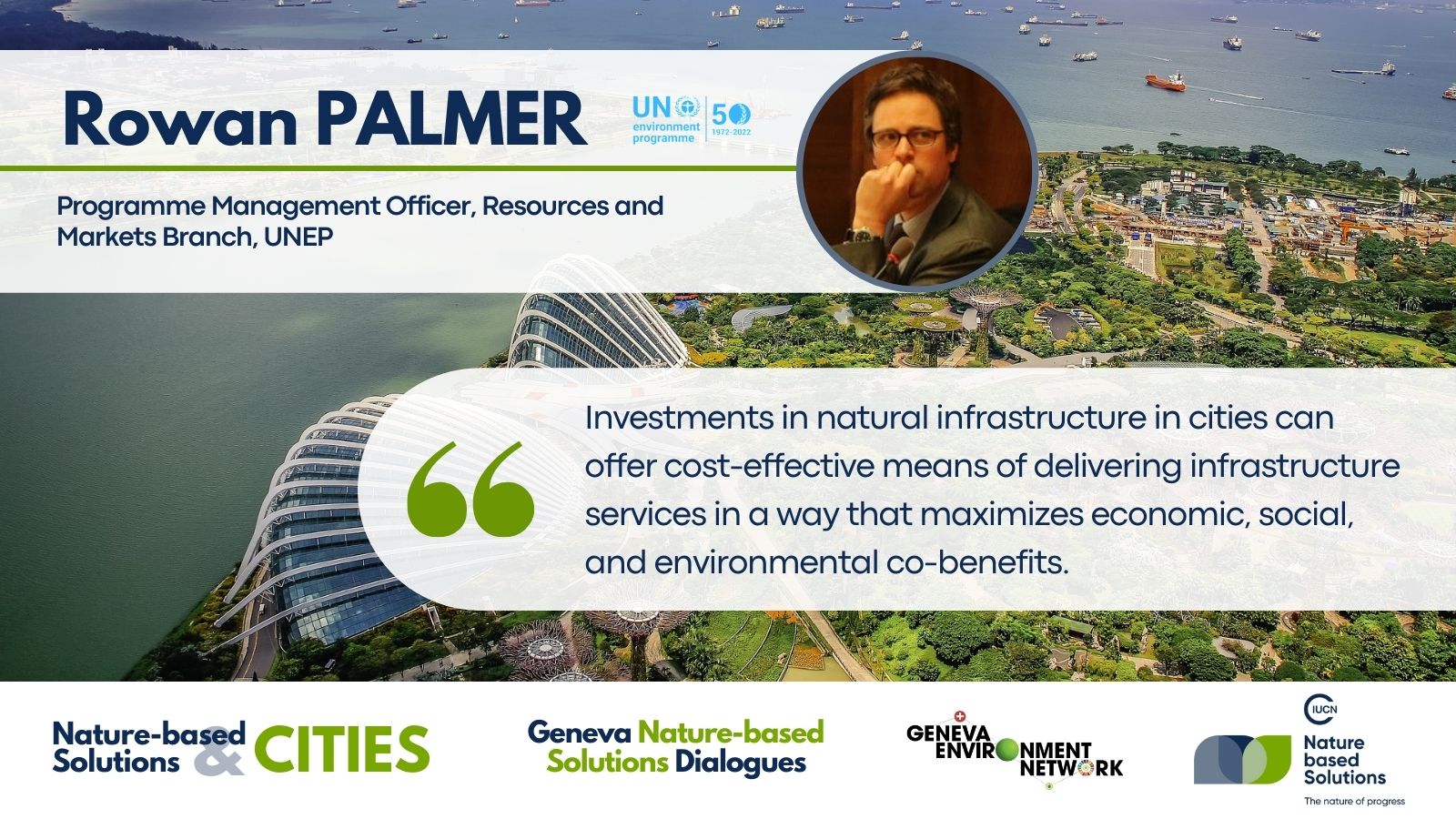
- Infrastructure sits at the heart of the SDGs. It influences 92% of the 169 targets across all 17 of the goals. This means that it touches upon the societal, environmental and economic aspects of sustainable development. There are complex interlinkages between these domains and sustainable infrastructure is both a challenge and an opportunity. It’s a challenge because it can be difficult to manage, but it’s an opportunity because well-planned investments in sustainable infrastructure can have positive impacts towards multiple goals at the same time.
- At UNEP, we work with different partners to support governments in adopting needs-based integrated approaches to sustainable infrastructure. This approach takes service needs as a starting point and then considers how to meet those needs in the most effective way that optimizes the synergies and trade-offs between the economic, societal and environmental outcomes of infrastructure development.
- A major part of this is the recognition of nature as infrastructure and prioritizing investments in natural infrastructure and nature-based infrastructure solutions, including integrating them with infrastructure development. This is particularly relevant in the urban context. In cities, especially large cities, there’s a huge concentration of infrastructure with a high potential for integrated infrastructure solutions, particularly with respect to nature-based solutions.
- The kind of services that nature-based solutions can provide are often particularly relevant for urban areas – benefits for public health in terms of air quality improvement, water purification, shade and cooling that can be provided by vegetation. In addition, nature-based solutions can be particularly effective at increasing climate resilience of other urban infrastructure. For instance, 21 of the 33 mega cities in the world are located in low-lying coastal areas. Nature-based solutions for flood protection, for example, will be important over the coming decades.
- Nature-based infrastructure solutions can have broad benefits and co-benefits but we need partnerships amongst different actors to quantify and communicate these benefits to different groups in order to mobilize the support, investments, and financing needed to implement nature-based infrastructure solutions at scale. Partnerships between the environmental, health and business communities, among others, are important because we need to design cities with nature and nature-based solutions in mind from the beginning. This means that different types of policy makers and practitioners, such as designers, biologists, urban planners, engineers and landscape architects in the public and private sectors need to partner and work together from the early stages of infrastructure planning.
- Cities do not only have nature in them, but they also exist within nature and within broader ecosystems. In addition to nature-based solutions in cities, we need to be thinking about investing in natural infrastructure outside of cities because it still provides many important services to urban populations. We need partnerships between different cities and communities that exist outside of the cities. At UNEP, we lead the sustainable infrastructure partnership, a network of partners working together to support countries implementing integrated approaches to sustainable infrastructure more generally and then specifically on nature-based solutions for cities.
Nature-based Solutions, a Successful Ingredient for Urban Sustainability Agendas | Chantal Van Ham, IUCN
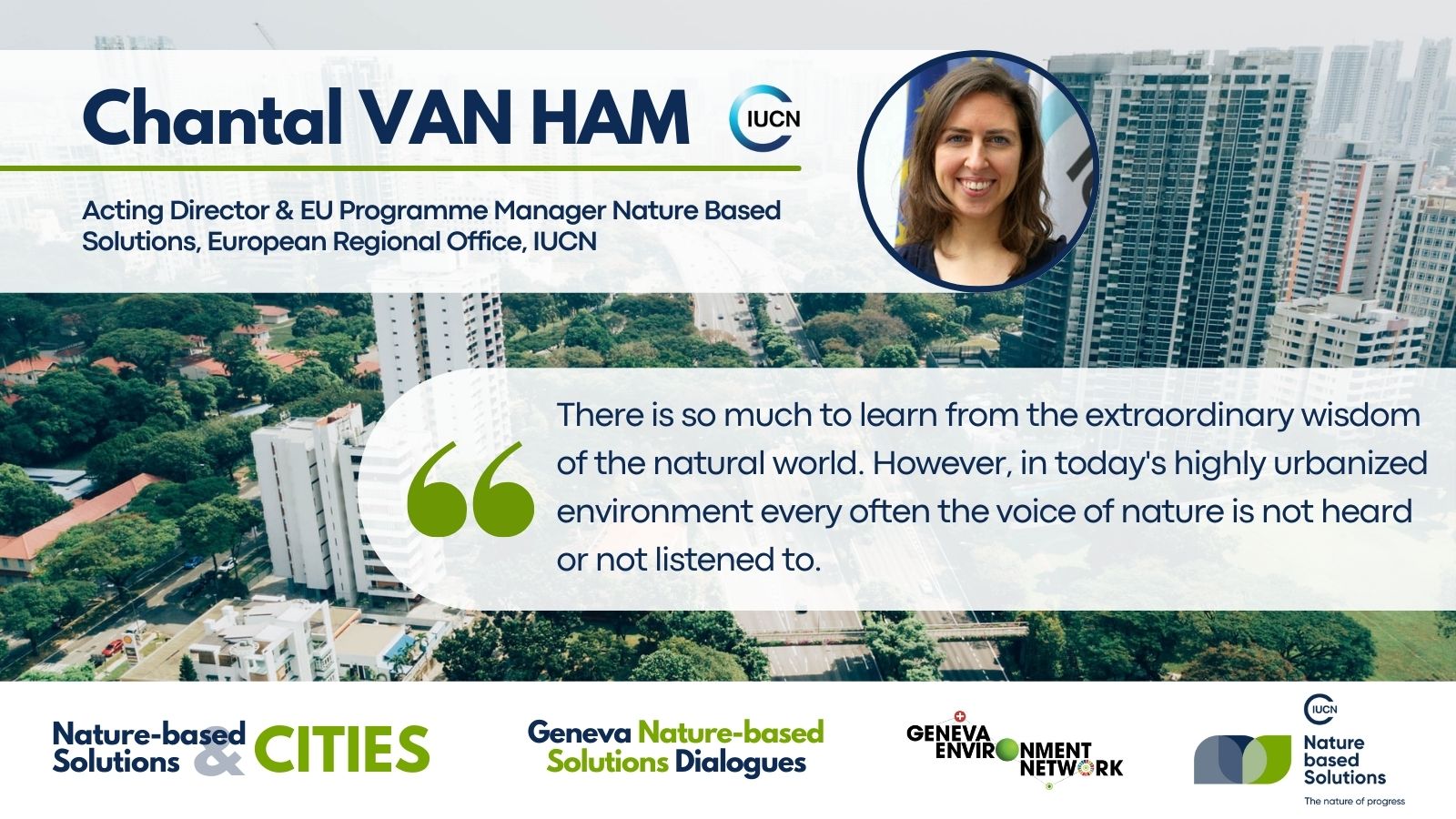
- It’s interesting to see the different perspectives on nature-based solutions, in particular as we have representatives from city networks, the private sector and also from cities. As we all work in our day-to-day life in different contexts with different partners and stakeholders, sometimes with conflicting agendas that all are based on that same landscape and with the scarcity of resources, we all share the same vision that we can only find a way forward if we bring together these various ideas and work together towards the solutions.
- Many who work in this field have realized that there is much more awareness for this opportunity that nature brings on the one hand through developments that we see happening in many countries of the world. Unfortunately, many climate-related disasters have showed us how impactful the destruction and degradation of nature can be, and how costly the restoration and rehabilitation from these impacts can be.
Second Panel – Nature-based Solutions for cities in action
Creating Sponge Cities with Nature-based Solutions | Helen Ding, WRI
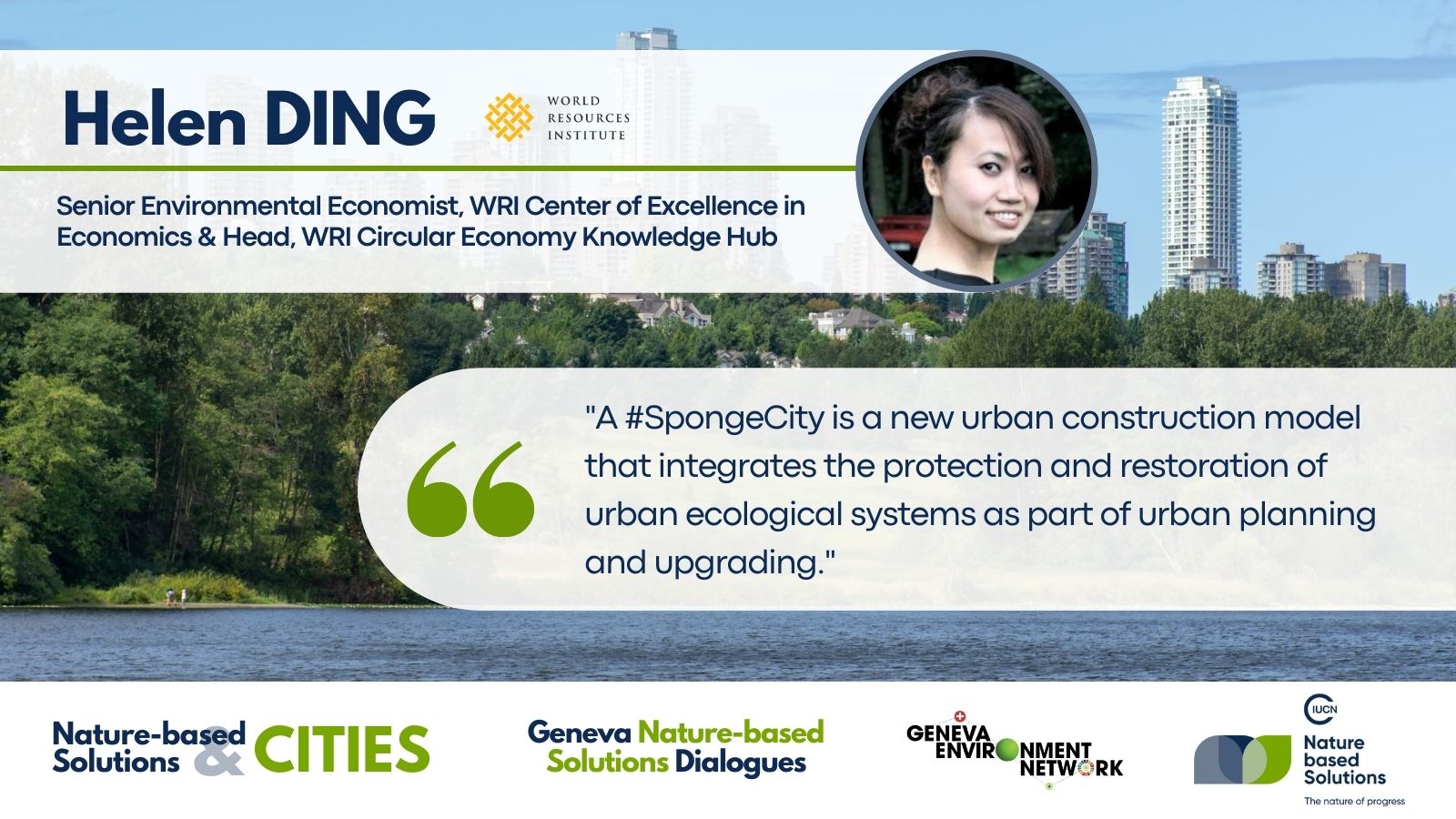
- Nature infrastructure is important not only as a solution to climate implication but also important for climate adaptation. Sponge city is one of the examples we could consider as an example of nature infrastructure to adapt to climate change impacts. We’ve also conducted the first of its kind analysis in China to systematically assess the economic returns of investing in nature-based solutions for increasing climate incident infrastructure in a rural urban and coastal environment.
- Sponge city is a new urban construction model proposed by Chinese researchers in 2014. The concept was originated from the Western concept of low-impact development, the difference is that it uses nature infrastructure such as green roofs, retention tanks and wetlands to absorb storm water and can also be applied to inland cities with abundant water resources. It is particularly useful for urban flood management by strengthening the ecological infrastructure and the draining systems in the city.
- Wuhan is one of the first 30 sponge city pilots in China. In our recent study, we found that in the two dimensions demonstration sites, nature-based solutions could help increase the total annual rent of control rates from below 70% to over 80 and can effectively mitigate urban flooding risks and build urban resilience in the face of climate change impacts. They can also generate important co-benefits such as increase property value, improve storm water recycling, increase groundwater recharge, and increase urban vegetation. They can also regulate microclimate sequester carbon control air pollution and increase recreational and ethnic value of the urban area around.
- The cities that are selected as part of the sponge city pilots in China have highly ranked GDP production every year although they are located in areas with high flooding risks. Between 2015 and 2016 about 30 cities have been and, more recently, in April 2021 another 20 cities were added to the pilot program. If it’s well implemented China could scale up these pilots to the whole country. It is an important opportunity and the policy priorities have been clear that constructing new infrastructure will be the priority for China – to increase the total resilience to climate change impacts going forward.
- Key challenges facing sponge city construction and other nature-based solution infrastructures include the systemic need and understanding of climate risks. We need a comprehensive understanding of the economic value. There is also the challenge of scaling up. In order to leverage more finance, it is important to identify mechanisms which will allow us to better quantify those benefits and leverage private capital to fill the financial gap.
Integrating Conservation and Biodiversity into City Development for Economic Recovery and Social Inclusion | Rodrigo Ravena, São Paulo City
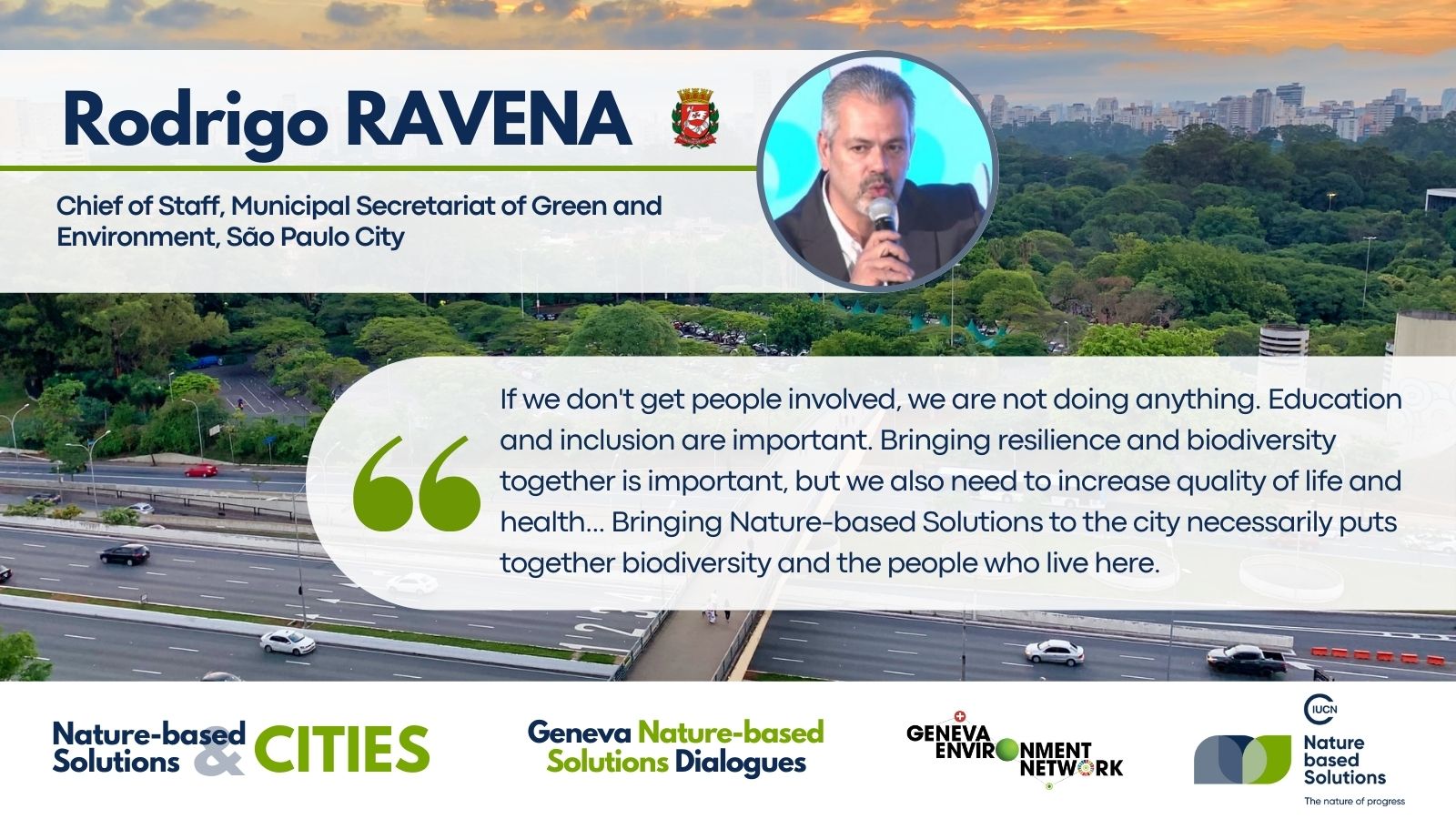
- In São Paulo, we have different nature-based solutions for each part of the city. In one area, we are increasing soil permeability and air quality with rain gardens and parks. In another area that is already quite green, we are trying to manage what we have implemented. In both cases, we have to maintain and increase these areas to sustain life and restore biodiversity in the city.
- In another part of the city occupied by buildings with very few green areas, we are creating corridors with tree planting to connect the small green areas in the middle of the buildings together.
- For the whole city, we have created laws to implement the actions. If someone is constructing in an area, we need to add green infrastructure, which is a priority in the city to create and connect the green corridors.
- We need the understanding of the population to preserve the areas as it costs to pay for environmental services. The people need to be part of the policies and understand that it’s better to preserve these areas for a sustainable economy. We involve them through education and inclusion and that it’s important for the city to include nature-based solutions to build resilience and restore biodiversity. Better cities also create jobs.
Protecting Natural Assets and Promoting Green Infrastructure for Urban Well-being and Resilience | Bongani Mnisi, City of Cape Town
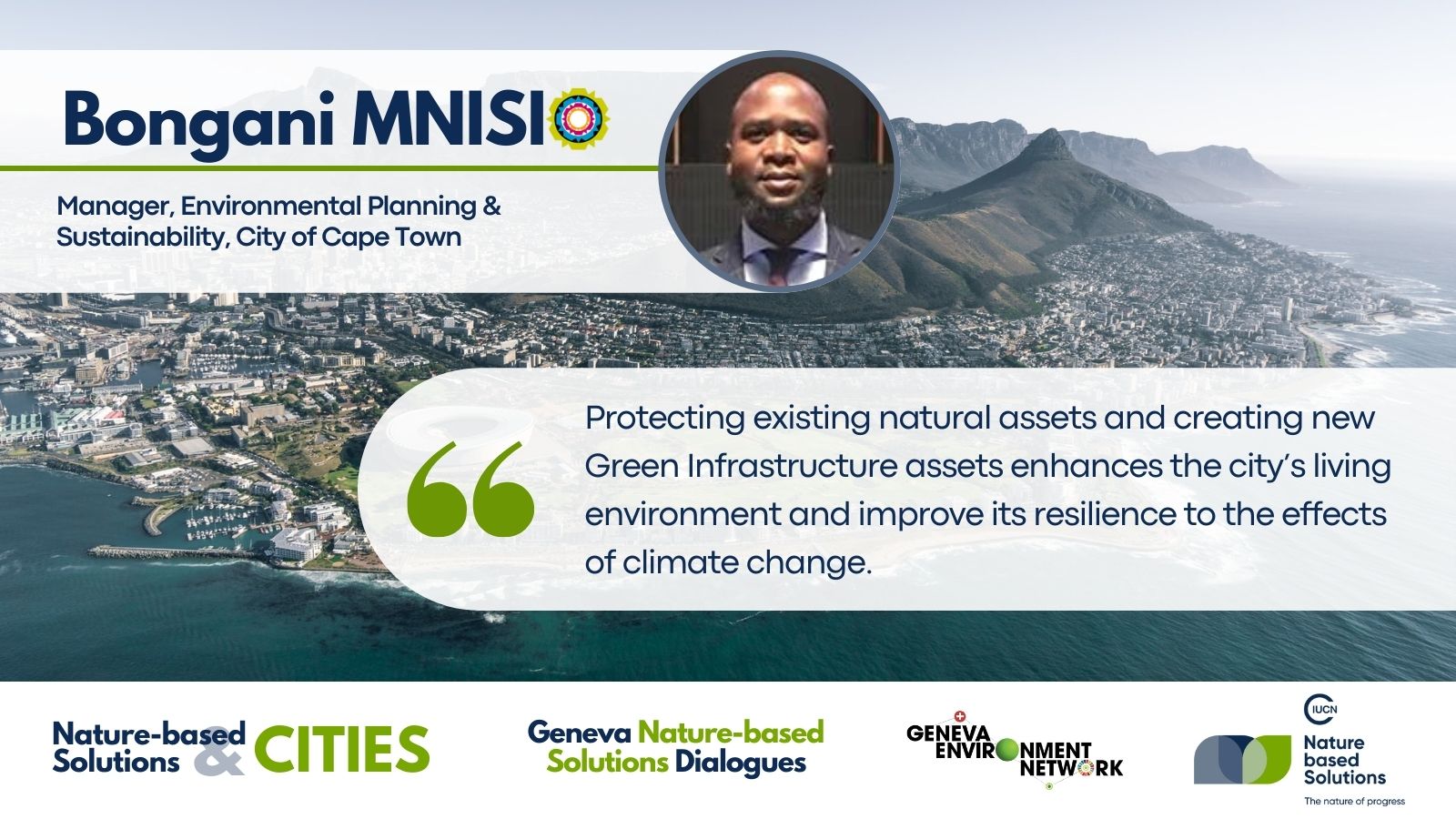
- For Cape Town, it’s important to map critical biodiversity. It’s one thing to have biodiversity but if it is not protected under national legislation for perpetual conservation, you might as well not do it. The next leadership may either build on it or change it into something else.
- With critical biodiversity projects, they need to be sustainably managed as well as restored. They are done to address societal challenges and to provide human well-being and biodiversity benefits. Under the Conservation Stewardship, since the inception in 2010, a total of 24 properties have signed Biodiversity Stewardship agreements. Twelve of these properties have signed perpetuity agreements totaling 2,262 hectares.
- Nature-based solutions are ways that the city develop, combining economic and societal benefits.
- In the green infrastructure network, we have proclaimed nature reserves in the city and also open green spaces in the urban area. A city without natural open spaces it is a dead city. Cape Town recognizes the value of having various guidelines, biodiversity action plans and an environmental strategy. It is critical to work with city policies to implement actions. There are about 55,000 hectares of biodiversity that is vested into natural spaces, about 22% of the city’s surface area. The city also cannot do it alone. Various properties are owned by private individuals and we work with them to have their land vested into biodiversity and perpetual conservation.
- Invasive species also take so much water. In one year, Cape Town nearly ran out of water. Between 2015 and 2018, 55 billion liters of water (approximately two months’ worth of water) are lost due to invasive species. 54,300 hectares have been cleared and is the most cost- effective and sustainable way to secure Cape Town’s water supply and meet future water demands. In addition, the Liveable Urban Waterways (LUW) is a strategic and transversal program to demonstrate how water sensitive design, waterway rehabilitation and a new approach to waterway management can achieve multiple benefits for society, the environment and the economy.
The Potential of Ecosystem-based Adaptation for Climate Justice in Urban Areas | Mariana Vidal Merino, PlanAdapt
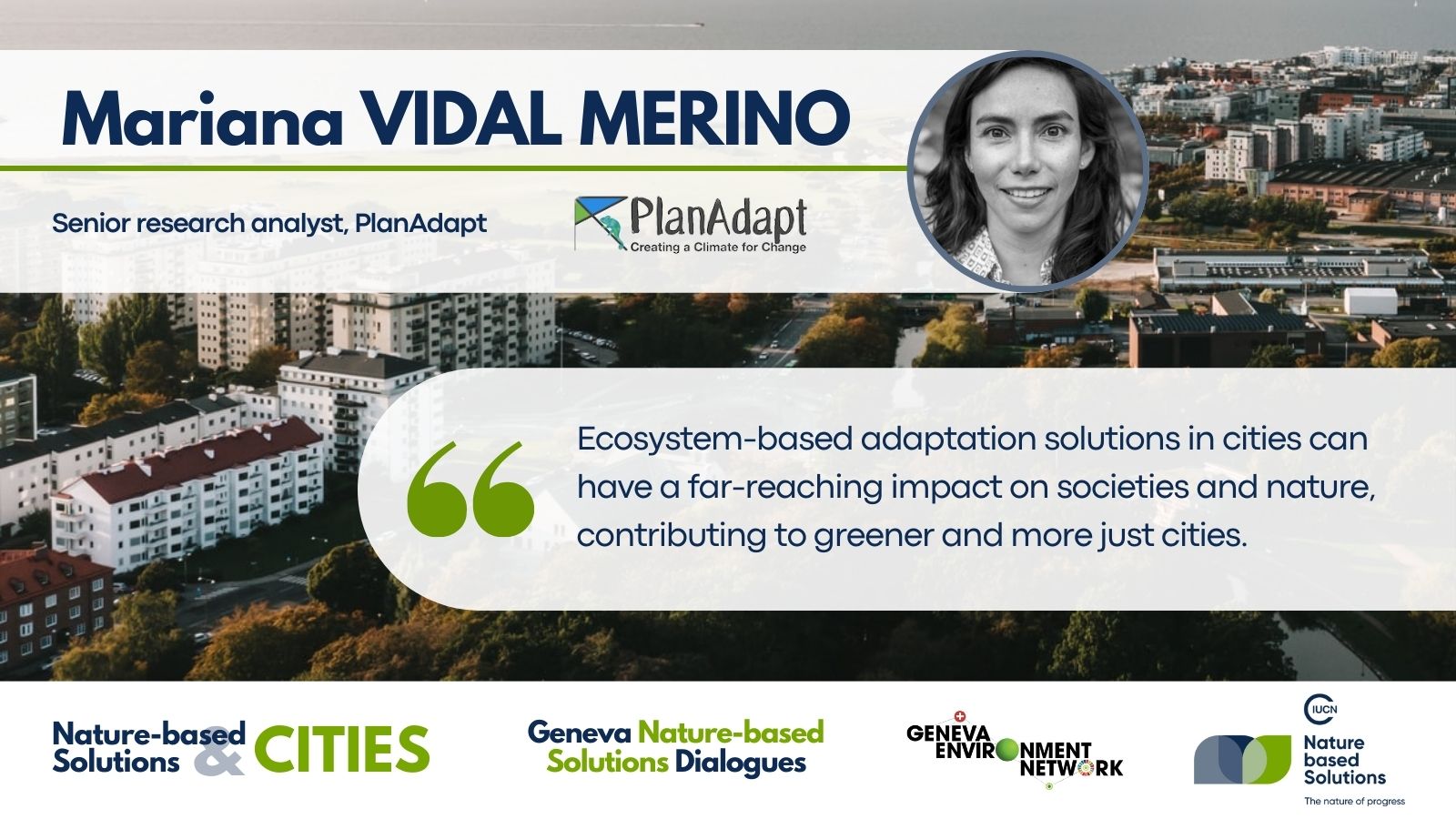
- I would like to keep exploring nature-based solutions challenges and opportunities under a climate justice perspective as we need to look at climate change in our cities as a problem that is not only of a physical or environmental nature but also very much political and ethical. Historically, marginalized communities – low income, people of color and indigenous groups – are the ones that bear the most the most acute impacts of climate change yet are also the least responsible for creating the problem in the first place.
- When implementing climate change solutions in our cities in general and, specifically, nature-based solutions we need to consider concepts of justice. Otherwise, what would happen is that we have a high risk of replicating or enhancing existing inequalities in our cities, which may include the unequal distribution of green and blue spaces within a given city which also leads to the unequal distribution of the environmental services that nature-based solutions provide.
- The social benefits of making our cities more beautiful or reconnecting people with nature are also linked to issues in reducing the urban heat island effect, noise, air pollution and risks of flooding. Another potential negative impact of implementing nature-based solution is that low-income communities may be outpriced for areas that have been aesthetically improved via implementation of nature-based solutions.
- In Lima, the areas where low income communities live or communities with a migration background coming from other regions of the country have a complete absence of green spaces. There is a stark between areas of high income and commercial areas versus more marginalized districts.
- In a recent study on climate justice for people and nature through urban ecosystem-based adaptations (EbA), the results highlight the remarkable potential of nature-based solutions to deliver social elements, such as participation and inclusiveness, capacity building, fairness, equitability in gender consideration and livelihood improvement. The majority of the case studies that we have analyzed stem from the global South and they reported a high degree of social considerations in both the design and implementations of EbA interventions. Case studies reporting far-reaching social impacts shows that nature-based solutions naturally have these predispositions of bringing about social benefits. While the results are encouraging, the evidence from nature-based solutions in the urban context of cities of the global South is still quite scarce.
Championing NbS – David Maddox
- There is a need to reach across boundaries of difference and to reach across boundaries of misunderstanding to different kinds of people who exist in the communities and cities that we all live in, so that they all share the same dream of making a better city. In that sense, we need to be active, to take action, to collaborate across those boundaries and recognize different points of view.
- One of the things I hold dear from my life in theater is the idea of collaboration, that we are many different types of people in theater. There are artists, set designers, costume designers, musicians, actors and directors who are all trying to work together from their own points of view – to create a better show that people would want to see.
- Cities are the same thing. There are many different points of view, stakeholders collaborating together from their points of view to make a better city. We can talk all day about what better means, we can talk all day about what a city means, but the fundamental idea is that we need to collaborate with each other. Through collaboration, we could create something we could not have created by ourselves.
- To do that, we have to strive to meet people where they are because different types of people use different languages, often to describe the same thing. Words like biodiversity don’t mean the same thing across the different elements of our societies. Even for landscape architects and ecologists, planners and business people, when you say the word biodiversity, they might not mean the same thing. Even words like wild don’t mean the same thing. We have to explore what the words mean to that’s the first step in creating cities that are better for both people and nature in which we can understand how we talk to each other. How can we create something that is better between each other. We can do these things but only if we actually try to be together.
Conclusion
The global pandemic has brought nature closer to people’s minds and hearts and our economic agenda in terms of the recovery plans should consider new ways of looking at how we manage resources and integrate that whole concept of nature and regenerative systems more into our practices and business decisions. The time is now for all of us to incorporate nature-based solutions and help bring life and integrity back to damaged ecosystems, stimulate economic recovery, and set ambitious targets to make our cities livable, resilient, sustainable, safe and inclusive. We need nature we cannot do it without nature.
Video
In addition to the live WebEx and Facebook transmissions, the video is available on this webpage.
Documents
Links
The update on Nature-based Solutions provides relevant information and the most recent resources, news and articles from the various organizations in international Geneva and other institutions around the world.
Discover more partnerships and initiatives around nature in cities:
- UNECE Trees in Cities Challenge
- Cities with Nature
- IUCN Urban Alliance
- Panorama Solutions for a Healthy Planet
- #NatureForAll
- The Nature of Cities
- UNEP Sustainable Infrastructure Partnership
- UN-Habitat Climate Action 4 Cities Campaign
Further resources on the topic of Nature-based Solutions in cities:
- What are Nature-based Solutions (NbS)? | Infographic | IUCN
- IUCN Global Standard for Nature-based Solutions: First Edition | IUCN | 2020
- Smart, Sustainable and Resilient cities: the Power of Nature-based Solutions | UNEP | 23 July 2021
- Smart, Resilient and Sustainable Cities Action Plan | Joint G20 Energy-Climate Ministerial Communiqué | 23 July 2021
- Nature Within Cities and Cities Within Nature | UNEP | 30 June 2021
- Urban trees and forests | UNECE
- Urban trees and forests in the spotlight as the UN Decade on Ecosystem Restoration commences | UNECE | 29 January 2021
- United for nature on World Cities Day | ICLEI | 30 October 2020
- Nature-based Solutions to Climate Change Feature Urban Forests | IISD | 26 September 2019
- Integrated Approaches to Sustainable Infrastructure | UNEP | 2019
- Sponge cities promise a wide range of benefits | WRI China | 22 November 2018
- How cities are using nature for sustainable urban development | ICLEI | 5 June 2017
- Nature-based solutions for sustainable urban development – Briefing sheet | ICLEI | March 2017
- Holcim launched nature-positive strategy with measurable 2030 biodiversity and water targets | Holcim | 3 September 2021

